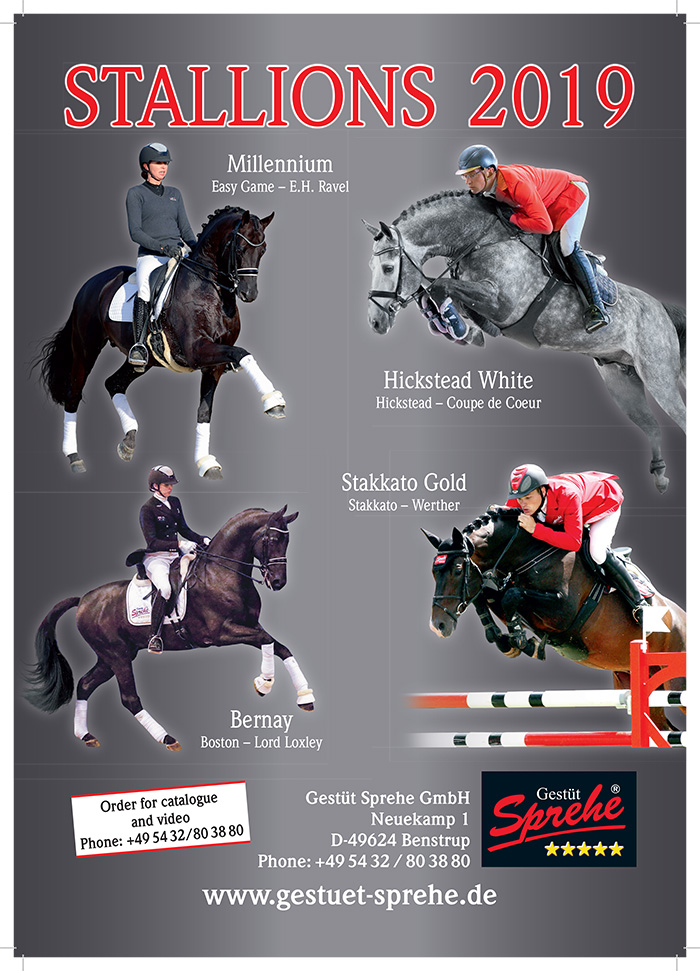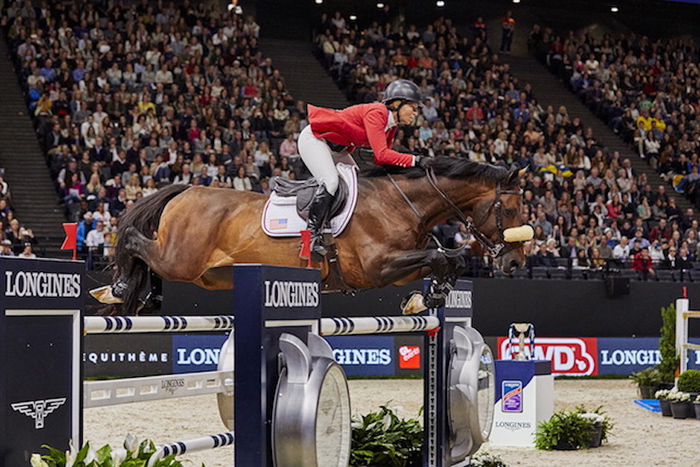
Beezie and Breitling LS win in Paris 2018, can they make it two in a row?
(FEI photo / Liz Gregg)
Christopher Hector talks to the defending champion…
Beezie Madden has been one of the enduring treasures of showjumping for almost two decades. In 2004 she was the first woman to amass $1,000,000 in winnings from showjumping, and the same year, won team gold at the Athens Games… In 2019, Beezie is still at the top of her game and comes to Göteborg as the defending champion, having won the cup in Paris last year. Lucky then to catch up with her, the day before the Jumping final began.
Can we talk about your basic principles when it comes to training and riding?
“My basic principles are to stick to the basics really. At the same time, I like to treat each horse as an individual. You can’t get too locked up into having one system for all horses, but I think we try to make everything have sense and having building blocks – when you start with a young horse you’ve got to work on the rideability, all the basic things before you can move up the levels. It’s the same thing with training riders, they need the basics, the correct position, in order to be able to influence the horse in the correct way. If you do your homework, that’s what leads to success.”
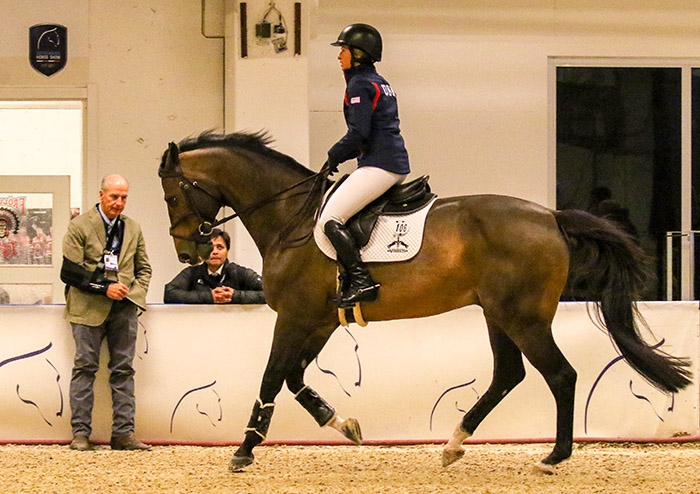
Working in at Göteborg – Beezie, Breitling and John…
Photo Kenneth Braddick / Dressage News
Are you working with something similar to the German Training Scale, rhythm, relaxation, before you get complicated…
“Probably I am a little more American, forward style seat riding than some of the Germans, but I think it is all getting quite similar now, they have more horses with more and more blood. The horses are becoming more similar, and so are the riders.”
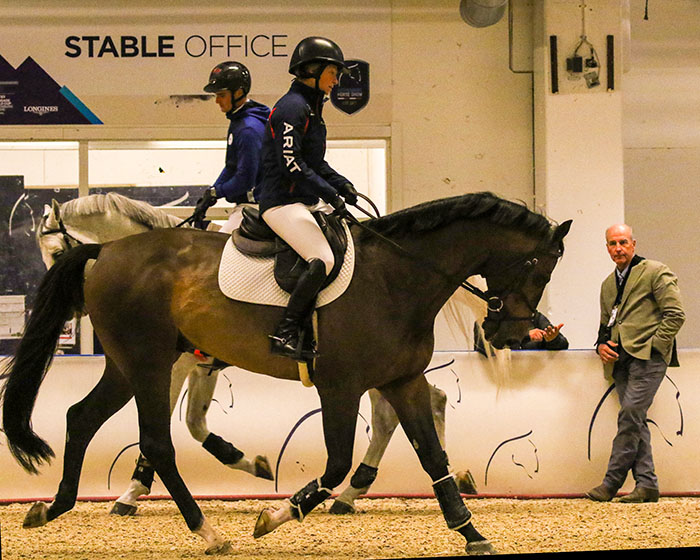
Would you prefer to ride a Thoroughbred horse?
“They are breeding Thoroughbreds now a much smaller size, much more speed, and not so many of them make it to jumping anymore, but I do like a horse with a lot of blood. I don’t like a horse that is too cold.”
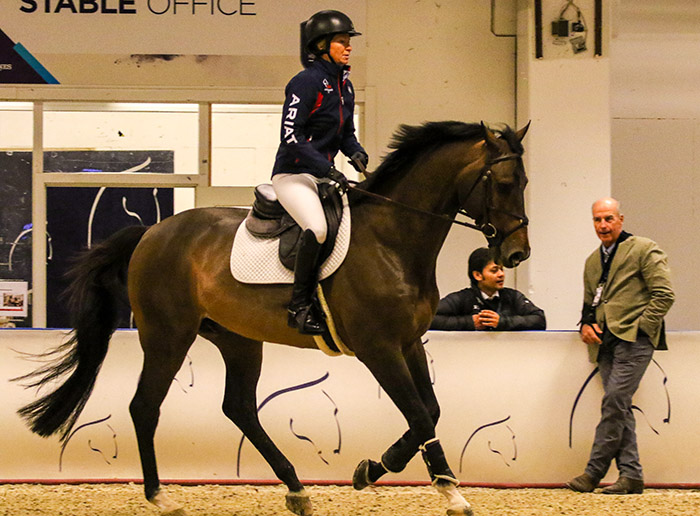
Can you tell me a little about the horse you’ve brought here to defend your title, Breitling…
“He’s thirteen, we’ve had him since he was seven. He came from Jeroen Dubbeldam. He was born in Mexico, on the La Silla Stud. He’s good for this competition because he’s quite rideable, he’s handy, he’s fast when I need him to be fast. He’s careful and he has enough blood to jump quite a few rounds – he proved it last year, we’ll see what he does this year.”
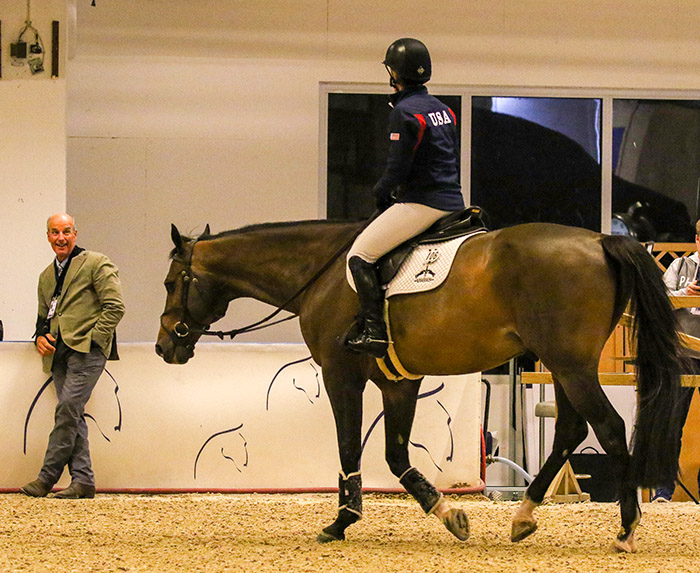
Have you given him a big prep or a light prep, coming here?
“He’s had a bit of a light season heading towards this. He did some indoor shows in the fall, he won the World Cup qualifier in Washington, then he had almost two months break, then we started him up in Wellington, he did three competitions, one was kind of a prep week, then another when he did the nations cup and then a third week where he did a five-star Grand Prix. I did several classes before that to make sure he was show-fit enough to jump enough rounds – he was third in the last Grand Prix so hopefully we have him peaking at the right moment, but you never know until you try…”
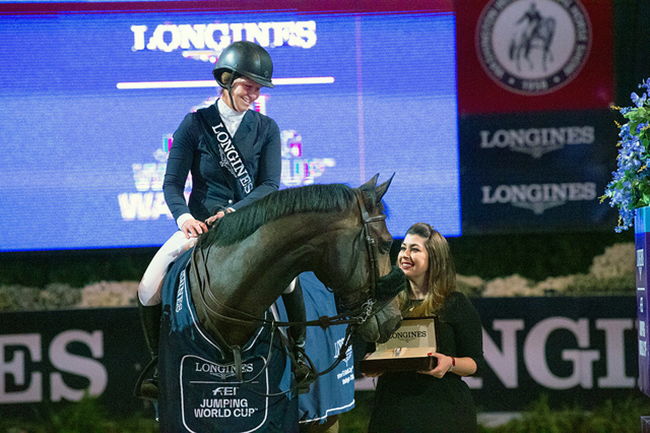
Beezie and Breitling win in Washington
What attracted you about Breitling in the first place?
“He was seven when we bought him and he had tremendous jumping ability. The moment we saw him on the cross-ties, he drew us towards him because he is not just beautiful but very classy looking. We’ve done business with Jeroen before so we had a lot of trust in him, we saw some videos of the horse… When I tried the horse, I loved the feeling and felt like I’d like to work with him.”
Getting a horse from Jeroen you know there is no trash on it, he is such a classy rider…
“And Jeroen had the horse since he was two, so he had a beautiful upbringing. We had a lot of confidence when we made that buy.”
Do you prefer to buy a horse like that – a horse that has been well started, or do you prefer to start them yourself?
“When you see a good horse, you have to jump on it. For sure it’s nice to work with a horse when he is young, then you feel when he is nine or ten you are ready to do something important, something big, if the horse is up to that. When you get them when they are older it takes time to get a partnership. If you get them when they are young you develop that partnership as they get older.”
What drove you to make riding and jumping your life?
“My parents had horses when I was born, so I grew up in a stable. I started riding when I was three or four years old in riding school, it was just a natural thing. I seemed to have some talent for it, I liked it. I love horses.”
Is it still as much of a buzz for you?
“Yeah, I love the competition, I love working with horses. The challenge of trying to find the next good horse, trying to win the next championship, or being a part of the team, it’s still there.”
Your parents, were they your first teachers?
“Pretty much, they always tried to have another person to teach the riding, but as far as horsemanship and taking care of the horses, it all came from my parents.”
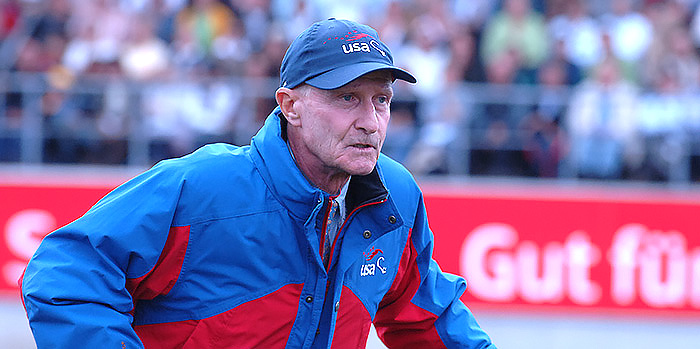
George Morris watching Beezie and Authentic at the Aachen World Championships
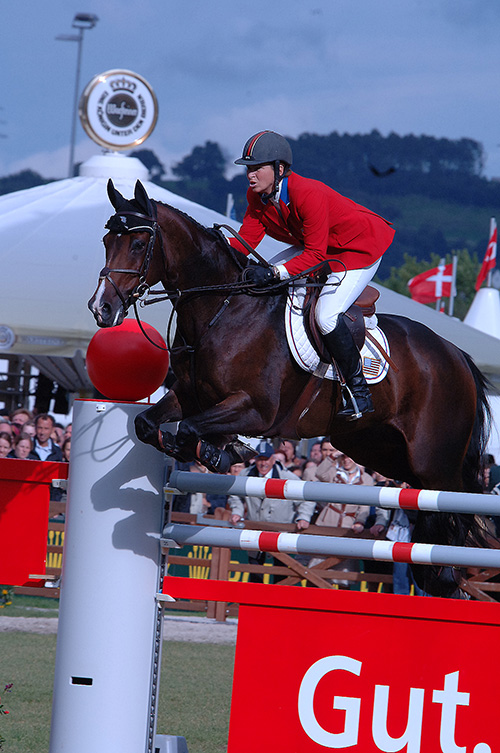
Who were the most important teachers for you?
“I don’t know, I had quite a few growing up. I trained with, and worked for, Katie Prudent when I was just out of college, actually just starting college, so I was with her for at least five years. Then I went to work for John, my husband now, he mostly had sale horses, but we kind of found a way to go to Europe and compete and developed owners over the years. George (Morris) has been a big influence for me. He rides my horses sometimes, he always has tips. My husband John and I have been working together since 1988.”
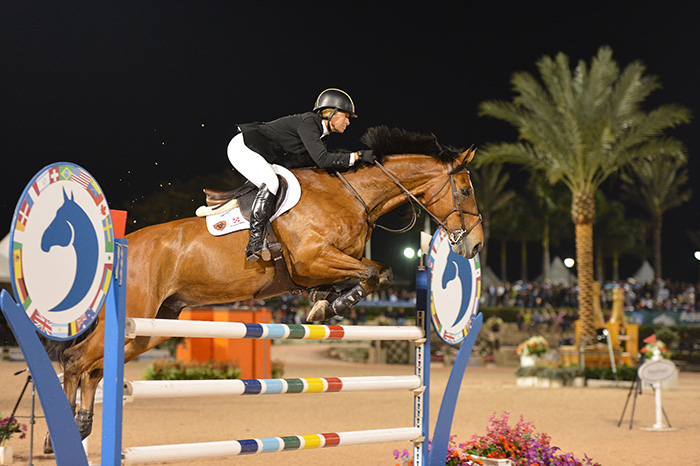
Beezie and Simon competing at Wellington in the US
Have you won here in Göteborg before?
“I won with Simon in 2013, another one from Jeroen!”
Good omen…
“Maybe.”
next we talk about course design…
Breeding a jumper in 2019? Want top European bloodlines? Go to www.ihb.com.au for top stallions like Diarado
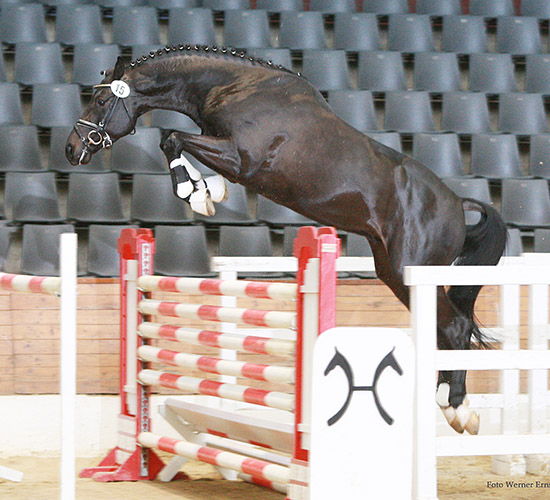
Do you like the way course designing has developed? George is always complaining that the sport is being ‘pussified’, that the distinctive jumps as being lost…
“I think we have to be careful that it doesn’t get too ‘cookie cutter’ but times have changed. Modern times, you have to think of horse welfare, the breeding of the horses we compete with has changed, less brute power and more quality and lightness, so I think we do have to evolve that way, but at the same time we have to keep some different kinds of fences, but I think the best shows still have those.”
Ludger Beerbaum, the other day, said to me that he thought with the banning of hind boots, breeders might have to concentrate on breeding horses with a better natural hind end. Do you use back boots?
“Probably on most horses, not all, but we do. Mostly we use milder ones.”
Will it be a bigger challenge, preparing them when you can’t use the boots?
“We used to live without them all the time. Actually, it will probably favor the better riders because if you don’t have the boots to help, you can’t just turn them in the air. It might slow some of the jump offs down a little, so the horse gets time to use its hind end properly. It’s going to be the same for everybody, it’s not like someone can use boots and someone can’t. I grew up without using any kind of hind boots. maybe in the end, it will be for the better.”
Are you a bit person, are you like Kathy Kusner with a suitcase full of bits?
“No, I don’t take a suitcase full of bits, I like pelhams, a little bit of gags, snaffles, but I don’t get too creative.”
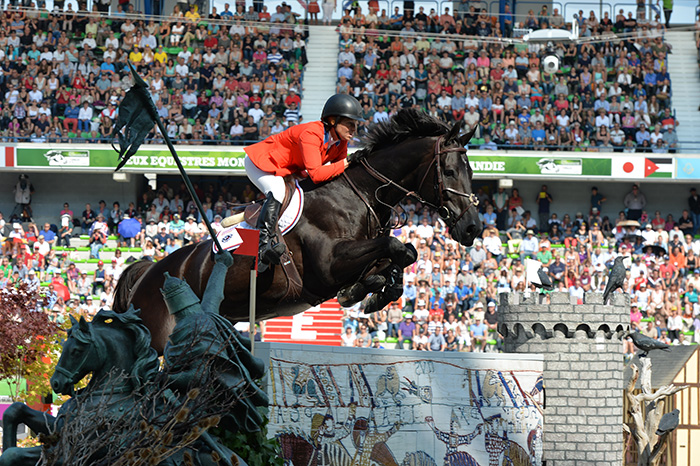
Beezie and Cortes in the Final 4 at Normandy, won by Jeroen Dubbledam
What is next for Beezie Madden?
“We have this week at the World Cup, then the possibility of the Pan Am Games, this summer for our US team, and then I would love to make the team for Tokyo.”
And how many Games would that be for you?
“Five.”
Wow that’s a fantastic record…
“If I can do it…”



